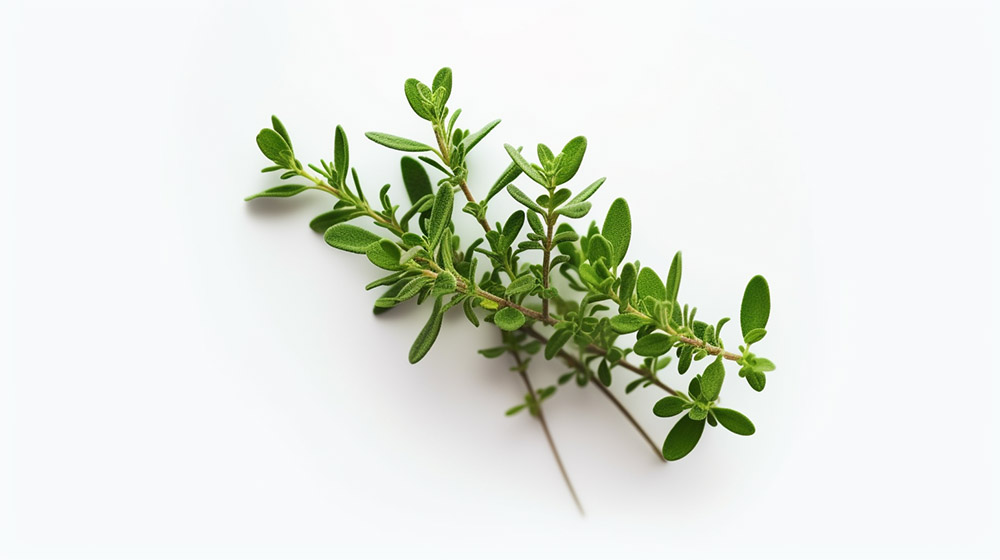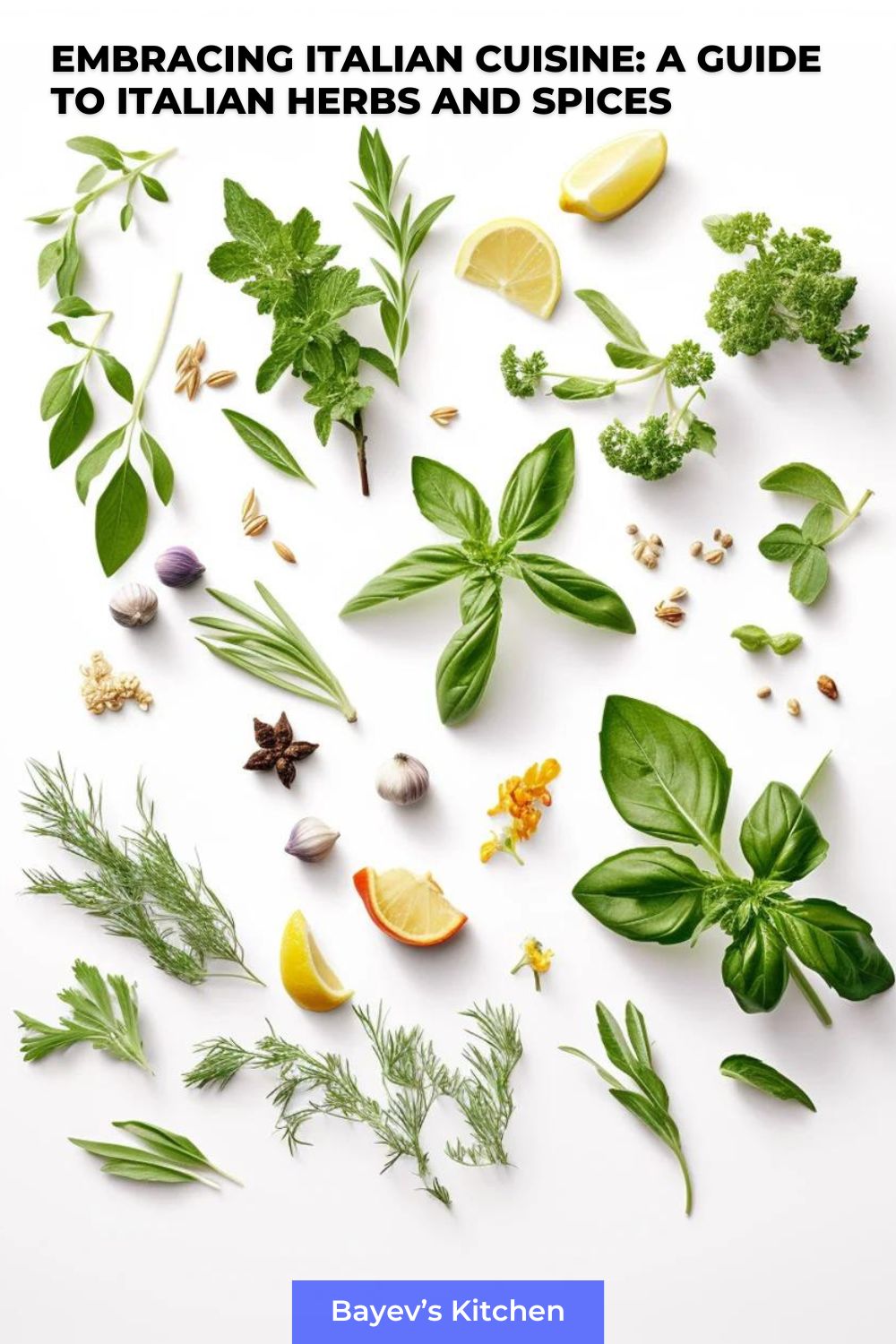Italian cuisine is admired and loved worldwide for its simplicity and the emphasis it places on high-quality ingredients. At the heart of this celebrated cuisine are its aromatic herbs and spices that provide unforgettable flavor profiles to its dishes.
Whether you’re new to Italian cooking or an established aficionado, understanding the nuances of Italian herbs and spices can help elevate your dishes to new culinary heights. Let’s embark on this flavorful journey together!
🔪 List of Italian Herbs and Spices
1. Basil
Basil, or ‘basilico,’ is synonymous with Italian cuisine. With its sweet, slightly peppery flavor, it’s the primary ingredient in pesto and an essential addition to a classic Margherita pizza. It adds freshness to salads, pasta dishes, and is often paired with tomatoes, mozzarella, and olive oil in a Caprese salad.
2. Oregano
Oregano, or ‘origano,’ is a key Italian herb with a warm, slightly bitter taste that is often used in pizza, pasta sauces, and marinades. Whether used fresh or dried, it imparts a robust flavor to dishes like spaghetti Bolognese and lasagna.
3. Rosemary
Rosemary, ‘rosmarino’ in Italian, is a hearty herb with a pine-like aroma and flavor. It’s commonly used in Italian roasts, such as porchetta, and vegetable dishes, particularly those with potatoes. Its sturdy leaves can withstand longer cooking times, making it ideal for slow-cooked dishes.
4. Thyme
Thyme, known as ‘timo,’ adds a subtle, earthy flavor to Italian dishes. It’s often used in slow-cooked dishes like ossobuco and stews, as its flavor develops over time. It also pairs beautifully with grilled vegetables and roast chicken.

5. Parsley
Parsley, or ‘prezzemolo,’ is a workhorse in Italian cooking. Its bright, slightly bitter flavor balances rich and hearty dishes. It’s commonly used in gremolata (a lemon, garlic, and parsley mixture) served with ossobuco, and is a staple in many pasta and seafood dishes.
6. Sage
Sage, ‘salvia’ in Italian, is used for its strong, slightly peppery flavor. It’s traditionally used in dishes like Saltimbocca, a veal dish layered with prosciutto and sage leaves, and brown butter and sage sauce often served with gnocchi and ravioli.

7. Garlic
Garlic, ‘aglio,’ is not exactly a herb, but it’s indispensable in Italian cuisine. It adds a pungent, spicy, and slightly sweet flavor to countless dishes, from the simple Aglio e Olio pasta to complex stews and roasts.
8. Fennel Seeds
Fennel seeds, or ‘semi di finocchio,’ have a sweet, anise-like flavor that’s used in both sweet and savory dishes. They’re commonly added to homemade sausages and are a key ingredient in biscotti.
9. Red Pepper Flakes
Red pepper flakes, ‘peperoncino,’ bring heat to Italian dishes. They’re often used in pasta dishes like Spaghetti all’Arrabbiata and Aglio e Olio, and sprinkled over pizza for an extra kick.

10. Bay Leaves
Bay leaves, or ‘alloro,’ have a subtle, slightly floral flavor that adds depth to sauces, stews, and soups. They’re a crucial part of the soffritto, the flavor base of many Italian dishes.
11. Nutmeg
Nutmeg, or ‘noce moscata,’ lends a warm, sweet, and slightly nutty flavor to Italian cuisine. It’s commonly used in dishes like spinach and ricotta ravioli and béchamel sauce, and it’s a critical ingredient in the classic Tortellini of Bologna.
12. Marjoram
Marjoram, or ‘maggiorana,’ has a sweet, floral, slightly citrusy flavor. It’s traditionally used in dishes from Liguria, such as the region’s signature basil pesto. It’s also often added to sausage mixes, meat stuffings, and vegetable dishes.
13. Juniper Berries
Juniper berries, ‘bacche di ginepro’ in Italian, are small, dark fruits with a pine-like, slightly sweet flavor. They’re traditionally used in Northern Italian game dishes, like venison and wild boar stews, and to flavor the Lombardy dish, cassoeula.
14. Anise
Anise, or ‘anice,’ has a strong, sweet flavor reminiscent of licorice. It’s often used in Italian baking, particularly in biscotti and other cookies, and to flavor liqueurs, like Sambuca.
15. Cloves
Cloves, ‘chiodi di garofano,’ offer a warm, sweet, and slightly bitter flavor. Though not extensively used in Italian cuisine, they’re key to some traditional dishes, like mostarda di frutta – a fruit and mustard-flavored syrup condiment from Lombardy.
16. Thyme
Thyme or ‘timo’ is not as common in Italian cuisine as in other Mediterranean cuisines, but it still finds its place, especially in the northern regions. Its minty, yet slightly lemony flavor is a beautiful addition to poultry dishes, stews, and roasts.
17. Lemon Balm
Lemon balm or ‘melissa’ is a lemon-scented herb that’s often used to flavor dishes like fish, poultry, and salads. It also finds use in desserts and beverages due to its sweet, citrusy flavor.
18. Lovage
Lovage or ‘levistico’ has a robust celery-like flavor. It’s more commonly used in northern Italian cooking, especially in broths, stocks, and stews. The young leaves can also be used in salads and mashed potato dishes.
19. Summer Savory
Summer Savory or ‘santoreggia’ has a flavor similar to thyme or marjoram but is slightly more peppery. It’s often used in bean dishes, soups, and stews.
20. Saffron
Saffron, or ‘zafferano,’ is one of the most precious spices in the world. It adds a vibrant golden color and a subtly sweet, earthy flavor to dishes. It’s the key ingredient in Risotto alla Milanese, a creamy rice dish from Milan.
21. Star Anise
Star Anise, ‘anice stellato,’ is primarily used in baking and liquor production in Italy, contributing a robust, sweet, licorice-like flavor. It’s a crucial component in the liquor Sambuca.

22. Poppy Seeds
Poppy seeds or ‘semi di papavero’ aren’t widespread in Italian cooking, but they’re used to decorate bread and rolls, especially in the northern regions. They have a nutty, somewhat sweet flavor.
23. Caraway Seeds
Caraway seeds, ‘semi di cumino,’ have a warm, slightly bitter flavor that’s somewhat similar to anise or fennel. They’re used sparingly in Italian cuisine, mostly in baking and in some regional sausages.
24. Sesame Seeds
Sesame seeds, or ‘semi di sesamo,’ are often used in Sicilian cuisine, influenced by the Arabic culinary tradition. They’re used to top local bread and traditional sweet treats like ‘giuggiulena,’ a sesame-coated cookie.
Italian Seasoning: What inside?
Italian seasoning is a blend of dried herbs commonly used in Italian cuisine.
The concept of “Italian seasoning” as a pre-mixed combination of spices is largely an American innovation. While the individual herbs that comprise the mix (basil, oregano, rosemary, etc.) have been used in Italian cooking for centuries, the idea to package them all together under the name “Italian seasoning” is not authentically Italian.
While the specific ingredients can vary by brand and homemade mixtures, a typical Italian seasoning blend includes:
- Basil
- Oregano
- Rosemary
- Thyme
- Marjoram
- Sage
- Savory
Some blends may also include ingredients like garlic powder, red pepper flakes, or parsley. If you’re making your own blend at home, you can adjust the proportions to suit your personal preference or use recipe below.
How to make Italian Seasoning Blend: quick and easy recipe
Italian seasoning is a blend of dried herbs, typically used to flavor many Italian dishes. Here’s a simple recipe to make your own at home:
Ingredients:
- 2 tablespoons dried basil
- 2 tablespoons dried oregano
- 2 tablespoons dried rosemary
- 2 tablespoons dried marjoram
- 2 tablespoons dried cilantro (optional)
- 1 tablespoon dried thyme
- 1 tablespoon dried sage
- 1 tablespoon garlic powder (optional)
Instructions:
- Measure out all of your herbs. If your dried herbs are whole-leaf, you might want to crush them a bit in your hand or use a mortar and pestle to break them down and release their flavors.
- Mix all the herbs together until they’re well combined.
- Store your homemade Italian seasoning in an airtight container in a cool, dry place. It should stay fresh for about 6 months to a year.
Remember, you can tweak this recipe to your liking. Some people like to add a bit of red pepper flakes for some heat, while others may prefer to leave out certain herbs. Enjoy using your homemade Italian seasoning in your favorite Italian recipes!
🧾 Facts about Italian Herbs and Spices
Italian cuisine is deeply regional, with each area boasting its distinct palette of flavors. Thus, the use of herbs and spices varies from region to region. In Southern Italy, for instance, you’ll find a heavier hand with spices and herbs like oregano and chili peppers, while Northern Italian cuisine tends to favor more delicate flavors from herbs like sage and rosemary.
Here are some intriguing facts about Italian herbs and spices:
- The most commonly used herbs in Italian cuisine are parsley, basil, and oregano.
- Certain Italian recipes call for specific herbs, and substituting one herb for another can significantly alter the dish’s taste.
- The blend of dried herbs known as “Italian seasoning” typically includes oregano, marjoram, thyme, rosemary, and basil, but isn’t traditionally used in Italy.
- Some of these herbs, such as basil, lose their flavor when dried and are typically used fresh in Italian cooking.
- The use of spices in Italian cuisine has been influenced by historical connections with the East through the spice trade.
💡 Tips about Italian Herbs and Spices
- Use Fresh Herbs: Whenever possible, use fresh herbs to maximize flavor in your dishes. They’re best added towards the end of the cooking process to keep their flavors vibrant.
- Store Properly: Store dried herbs and spices in a cool, dark place. Exposure to heat and light can degrade their flavor.
- Mind the Expiry Date: Herbs and spices don’t last forever. They typically lose their potency after a year, so it’s a good idea to replace them regularly.
- Use in Moderation: Herbs and spices should complement, not overpower the main ingredients in your dish.
- Experiment: Don’t be afraid to experiment with different combinations of herbs and spices. Italian cooking is all about balancing flavors.
Embarking on this aromatic journey through Italian herbs and spices is the first step in mastering Italian cooking. As you become more familiar with these flavors, you’ll be able to create dishes that truly sing with authenticity

